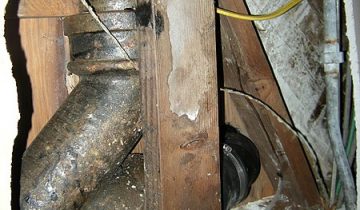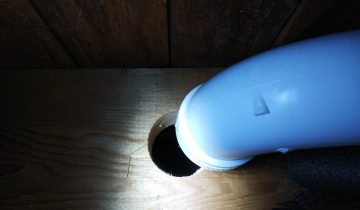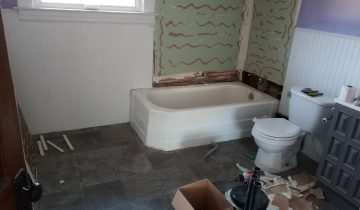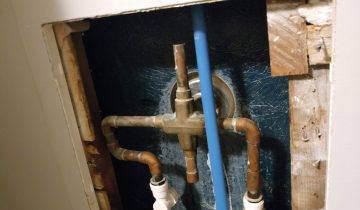Not gonna lie. I don’t want to go into the hoard right now if I don’t have to.
S’freezing over here. Well, maybe not today, but in general.
Luckily the water is off, and has been for some years, so there’s no real risk in letting the house sit another winter. Or maybe just a half winter. Time marches on, after all. This gives me time to brood over the changes I want to make per the last post.
Electrical Upgrades
I have a strong inkling that many of the wires inside of the house are either out of spec (cloth covered), brittle from age, or chewed by mice. So, its very likely that the entire house will require an eventual rewire.
I’ve been checking around for some ballpark figures, and various rules of thumb that I was able to dig up indicate that around $1 per square foot would be a good cost estimate for materials, which gives me a budget of around $1200. And, square footage should also indicate the amount of wire needed. My materials should then include:
- 200A service panel
- various breakers
- ~1500′ of various gauges and types of wire
- boxes, plugs, and switches
And, since we are at it, I’ll probably want to add:
- cat 5e cabling and receptacles
- coax cabling and receptacles
- 14/3 wire for smoke detector system
The upgrade of the service panel is dependent on the gauge of wires coming in from the meter. And for that matter, the maximum amperage of the meter box, the wire from the meter up the mast, and the service from the mast to the street. I know that this final segment was recently replaced because of ice damage, and is a plenty hefty 4/0 gauge aluminum. But, if the wires down the mast are only 2 or 4 gauge, I would need to add a 200A meter box, new PVC mast, and service wiring.
Or, if the exterior components dont jive, just keep the box at 100A. Sounds a lot simpler.
Furnace Upgrades
As a person who has had several furnaces installed, I can tell you. Installing your own furnace is quite a money saver.
In fact, one would save so much money that it would be prudent to price the bells and whistles.
As long as I’m putting in a furnace, why not add the humidifier and central air as well? I’m thinking 60k BTUs to replace the existing, but with much higher efficiency, as well as a 1.5 ton cooler. All of that adds up to around $2500 when you include piping, and throw in another $500 or so for cleaning out the ducts.
Even though cleaning up the old furnace, a Sears Fifteen, could make it work, it has probably lost so much efficiency in its 40+ year lifespan that it would be more cost effective to replace it outright.
Water Heater
And, let’s not forget, we’ll definitely need a water heater as well. The old furnace and water heater vent out the chimney, which we know is collapsed. I’m trying to avoid using it as much as possible, so as to delay any masonry work. This means a direct-vent traditional hot water heater, or a tankless model, either of which can be vented through the sidewall like the furnace. Co-venting high efficiency furnace and water heaters through the same PVC line seems to be a big question mark, so I can count on adding a separate vent just for the water heater.
Where are the contractors?
Yeah, I could get a contractor to do the work, sure. This saves me a lot of time, and the work is pretty much guaranteed to get done in a certain time frame. But then you and I wouldn’t learn much, would we?
We still want to do as much of the work ourselves as possible. You get a certain sense of pride when doing something yourself, as well as a clear picture of the system you are installing for later troubleshooting, and precision of the finishing touches that a contractor won’t attend to. Like the accuracy of the pass through holes for a sidewall vent, or the leveling of the furnace so that the access door can be installed flush without torquing it. A lesser accuracy is just as functional, and according to the city, safe. But when you look at some of the work done on our projects by contractors, coupled with the price paid, I see the flaws and sometimes just wish we had done it ourselves.
That brings up the point of cost savings, too. A full house rewire from a contractor increases my estimated budget ten times from around $1200, to between $10,000 and $15,000! A furnace and AC installation? Four times higher; $10,000 or more. Add a standard water heater at $1200 installed, or a tankless model at $3000, three times my cost.
Replacing all of these systems through contractors at average prices would cost more than the house did.
In the auto industry, one would use the term totaled.
What about the permits?
But, we still want the installations on the hoard to be safe. This means coaxing the city to come and inspect the systems. There are only two ways you can get a mechanical, electrical, or building permit in this here town. You have to be a master level contractor for the work being done, or you have to be the homeowner occupying the single-family residence on which you are doing the work. I’ll basically be living in the hoard for the next few months anyway, so hopefully they will let me into that second category.
The remaining options are to use a real contractor just to get a permit, who will then ‘sub contract’ the work to me. When the work is done, ideally they check it over (they are putting their name on it after all) and then call the city for the inspection. This is entirely plausible, and our backup plan if the city won’t recognize the homeowner exception.
I could also register as a master electrician for $200. I can probably cram for the test, and learn a lot in the process, but the 12,000 work hour prerequisite puts a damper on things. A master’s license would come in handy later, though…
Or, we could go totally off the radar and just do it. Nobody likes this plan. I have done a lot of work on buildings myself of varying levels of danger, but some of the planned work (specifically wiring up to the meter, adding a furnace and air conditioner, uninstalling a gas appliance and capping the line) is more fatally dangerous in the long term. Fires and explosions. Having an inspector come by and make sure you turned the right bolts the right number of times is paramount.
Now what’s the plan?
The plan is to keep making the plan. Because turning the heat on requires orchestrating the gas hookup, electrical hookup, and furnace replacement, all of those permits have to be organized together as well. Contacting the city to see what we are able to do on our own is in our future.
In the meantime, It’s pretty darn cold out there.



